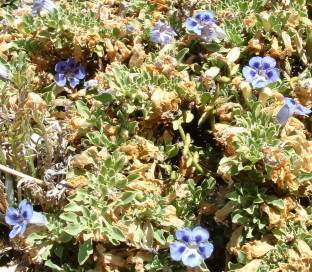Aptosimum procumbens
Aptosimum procumbens (Lehm.) Steud.
Family: Scrophulariaceae
Common names: carpet flower, Karoo violet (Eng.); kankerbos (Afr.)
Introduction
An ideal water-wise ground-cover plant for dry gardens, Aptosimum procumbens is one of the treasures of the arid and semi-arid parts of South Africa.

Description
Description
These perennial plants form 'carpets' of up to 1 m in diameter. When in full bloom the plant is covered with dark blue or violet, trumpet-shaped flowers that can appear at any time of the year but mostly during spring to summer. Leaves are alternate, usually densely crowded, on long or short shoots, linear, lanceolate, elongated or spathulate entire. The fruit is a thick-walled capsule opening at the top and often persists after seeds are dispersed.
Distribution and habitat
Distribution description
A. procumbens, and other species of Aptosimum, have a wide distribution range from parts of Namaqualand, Bushmanland, the Great Escarpment, the Northern, Upper, Great and Little Karoo, Northern Cape and Namibia. It often occurs in abundance on floodplains, flats, ridges, crowns, disturbed ground and mountain plains.
Derivation of name and historical aspects
History
The name Aptosimum is Greek in derivation, a meaning not and ptosimos meaning deciduous (which in turn comes from ptosis meaning fall) and refers to the fruit, a capsule, which is retained on the plant even after the seeds have been released.
Ecology
Ecology
The trumpet-shaped flowers are clearly designed for insect pollination and the flower petals acts as ideal landing pads. Their shape and colour lead to the assumption that bees are their pollinators. They are 'gullet flowers' which means that the corolla is tubular over the greater part of its length and very narrow in the basal region, protecting the nectaries from all but long tongues or minute visitors.
Although bees visit flowers from time to time, it appears that the primary pollinators are pollen wasps (Vespidae, Masarinae), particularly from the genus Celonites. Even more peculiar is that Karoo violets receive more frequent visits from specific species of Celonites in specific distribution localities, C. clypeatus and C. andreis for example, throughout the Karoo. These little wasps, on average about 10 mm long, are blackish and have red or red and white markings. They have long retractable tongues with which they collect the nectar.

Uses
Use
It is quite surprising that Karoo violets with their striking beauty have received very little horticultural research, as they really show great potential as garden plants especially in the dry parts of the country. With specific selection and mass cultivation there should be no reason why they can't be used in flower boxes, hanging baskets or ground covers and become just as popular as our pelargoniums, senecios, etc. It is recorded that Aptosimum was cultivated as an ornamental in England from seed sent there by Burchell and Ecklon from as early as 1815 to in about 1828.
The plants are said to be of medicinal value and are used to treat krimpsiekte in sheep, an acute and serious condition that affects the joints, muscles and stomach, often resulting in starvation and ultimately death.
Growing Aptosimum procumbens
Grow
There is no doubt that Karoo violets would do well as garden plants. They can be used as pot subjects, in hanging baskets, in flower boxes and as ground covers. Plants prefer sunny positions and can withstand prolonged periods of drought, making them ideal for a water-wise garden. Another unusual application is planting Aptosimum between paving slabs in the same way that ornamental grasses are used to soften surfaces.
Although very possible, some difficulty is experienced with propagating plants from seeds. A better option is to propagate plants from cuttings. Only the soft and young tips of shoots should be used and material must be sought from healthy and vigorously growing plants. Cuttings must be about 10 mm long and planted in a coarse, sandy medium which must be kept moist and warm.
References
- CODD, L.E. 1983. Aptosimum procumbens. The Flowering Plants of Africa 47: t. 1880.
- GESS, S. 2000. Karoo violets and pollen wasps. Veld & Flora 86: 170, 171.
- LEISTNER, O.A. (ed.) 2000. Seed plants of southern Africa: families and genera. Strelitzia 10. National Botanical Institute, Pretoria.
- SHEARING, D. 1997. Karoo. South African Wild Flower Guide 6. Botanical Society of South Africa, Cape Town.
Credits
Werner Voigt
Karoo Desert National Botanical Garden
December 2003
Plant Attributes:
Plant Type: Ground Cover, Perennial
SA Distribution: Eastern Cape, Free State, North West, Northern Cape, Western Cape
Soil type: Sandy, Clay
Flowering season: Late Summer
PH: Alkaline, Neutral
Flower colour: Blue, Mauve/Lilac
Aspect: Full Sun
Gardening skill: Average
Special Features:
Horticultural zones










Rate this article
Article well written and informative
Rate this plant
Is this an interesting plant?
Login to add your Comment
Back to topNot registered yet? Click here to register.